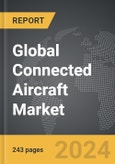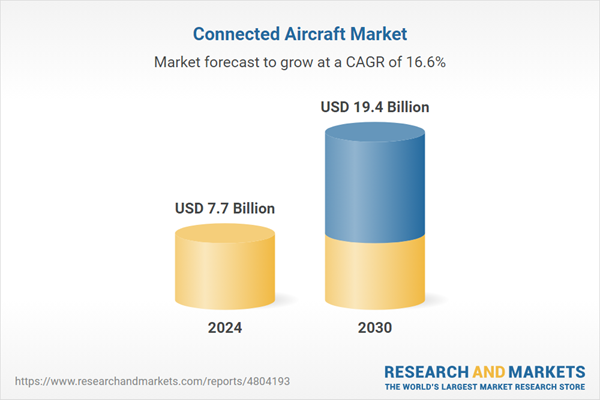The global market for Connected Aircraft was valued at US$7.7 Billion in 2024 and is projected to reach US$19.4 Billion by 2030, growing at a CAGR of 16.6% from 2024 to 2030. This comprehensive report provides an in-depth analysis of market trends, drivers, and forecasts, helping you make informed business decisions.
Global Connected Aircraft Market - Key Trends and Drivers Summarized
Why Is Connected Aircraft Technology Redefining Aviation?
Connected aircraft technology is transforming the aviation industry, revolutionizing how airplanes operate, communicate, and enhance passenger experience. At its core, a connected aircraft is equipped with advanced communication systems, sensors, and data-sharing technologies that allow real-time transmission of information between the aircraft, ground operations, and even other planes. This connectivity enables significant improvements in operational efficiency, safety, and maintenance. For instance, real-time data sharing allows airlines to monitor the condition of various aircraft components while in flight, detecting potential issues before they become critical problems. This predictive maintenance capability not only improves safety but also reduces unscheduled downtime, minimizing costly delays and cancellations. Additionally, connected aircraft systems enhance air traffic management by enabling more precise navigation and communication between pilots and ground control, allowing for smoother flight paths, fuel efficiency, and reduced emissions. In-flight connectivity also plays a crucial role in enhancing the passenger experience, providing access to high-speed internet, entertainment, and real-time updates. As the aviation industry becomes increasingly reliant on digital technologies, connected aircraft are at the forefront of this evolution, driving efficiency, safety, and customer satisfaction.How Do Connected Aircraft Improve Operational Efficiency and Maintenance?
One of the most significant benefits of connected aircraft technology is its ability to enhance operational efficiency and streamline maintenance procedures. Traditionally, aircraft maintenance has been largely reactive, with repairs and servicing performed after issues arise. However, with connected aircraft, sensors and onboard systems continuously monitor the performance of key components, such as engines, landing gear, and avionics. This data is transmitted in real-time to airline operations and maintenance teams, allowing for predictive maintenance. By identifying potential failures before they occur, airlines can schedule maintenance during routine ground time, avoiding costly disruptions and ensuring the aircraft remains in optimal condition. This proactive approach not only reduces the frequency of unplanned maintenance but also extends the lifespan of critical components, lowering overall maintenance costs. Connected aircraft also enhance operational efficiency by optimizing flight paths and fuel consumption. Through real-time data exchanges with air traffic controllers and other aircraft, pilots can adjust routes to avoid turbulence, optimize altitude for fuel efficiency, or avoid weather-related delays. This dynamic decision-making reduces fuel burn, lowers emissions, and shortens flight times, benefiting both airlines and passengers. Furthermore, by sharing data with ground operations, connected aircraft help improve turnaround times between flights. Ground crews can be better prepared to perform necessary tasks, such as refueling, cleaning, and cargo loading, based on real-time information about the aircraft's condition and needs.How Is Connected Aircraft Technology Enhancing Passenger Experience?
The advent of connected aircraft is not only transforming the back-end operations of airlines but also greatly enhancing the passenger experience. In-flight connectivity, once a luxury, is now becoming an expected feature for many travelers. Connected aircraft enable high-speed, reliable internet access, allowing passengers to stay connected with the world below, stream entertainment, and engage in work or leisure activities during their journey. This improved connectivity extends beyond just Wi-Fi access; it also includes real-time flight updates and communication with airline personnel. Passengers can receive real-time information about flight delays, connecting gate details, and baggage claim updates directly to their personal devices, reducing anxiety and improving overall satisfaction. Beyond internet access, connected aircraft systems are paving the way for more personalized travel experiences. Airlines can gather data on passenger preferences, from seat choices to in-flight meal selections, and use this information to tailor services for individual travelers. In-flight entertainment systems are also benefiting from connectivity, offering a broader range of content that can be streamed on demand rather than relying on pre-loaded options. Additionally, connected aircraft can improve cabin comfort by enabling real-time adjustments to cabin lighting, temperature, and even turbulence mitigation systems, ensuring a smoother and more enjoyable flight experience.What's Driving the Growth of the Connected Aircraft Market?
The growth in the connected aircraft market is driven by several interrelated factors, all of which are transforming how airlines operate and meet the demands of modern aviation. One of the most important drivers is the increasing demand for in-flight connectivity, as passengers and airline operators alike expect reliable, high-speed internet access and enhanced communication capabilities during flights. In today's hyper-connected world, the ability to stay online while airborne is no longer seen as a luxury but as a necessity, particularly for business travelers. This demand has pushed airlines to invest heavily in connected aircraft technology to meet customer expectations and maintain competitiveness in the market. Another significant driver is the advancement of data analytics and predictive maintenance technologies. Airlines are under constant pressure to reduce operational costs, and connected aircraft provide a solution by enabling real-time monitoring of aircraft systems. Predictive maintenance, powered by big data and IoT sensors, allows airlines to address potential mechanical issues before they cause flight disruptions, reducing downtime and repair costs. As the technology becomes more sophisticated and widely adopted, more airlines are implementing these solutions to improve efficiency and reliability. Additionally, the push for greener aviation is driving growth in the connected aircraft market. Governments and regulatory bodies are setting stricter environmental targets, and airlines are looking for ways to reduce their carbon footprints. Connected aircraft, with their ability to optimize flight paths, reduce fuel consumption, and improve overall efficiency, are seen as a key component in achieving these sustainability goals. The aviation industry is increasingly relying on these technologies to meet emission reduction targets while maintaining profitability. Lastly, advancements in air traffic management systems are also propelling the market forward. Connected aircraft enable more efficient communication with ground control and other aircraft, improving air traffic coordination and reducing congestion in the skies. This leads to smoother, more efficient flights, shorter delays, and better use of airspace, all of which contribute to cost savings and improved safety. The convergence of these technological advancements, passenger demand, operational efficiency, and regulatory pressures continues to drive the rapid expansion of the connected aircraft market, shaping the future of global aviation.Report Scope
The report analyzes the Connected Aircraft market, presented in terms of market value (US$ Thousand). The analysis covers the key segments and geographic regions outlined below.Segments
Connectivity (Air-to-Ground Connectivity, Inflight Connectivity, Air-to-Air Connectivity); Frequency (Ku-Band, Ka-Band, L-Band).Geographic Regions/Countries
World; United States; Canada; Japan; China; Europe (France; Germany; Italy; United Kingdom; Spain; Russia; and Rest of Europe); Asia-Pacific (Australia; India; South Korea; and Rest of Asia-Pacific); Latin America (Argentina; Brazil; Mexico; and Rest of Latin America); Middle East (Iran; Israel; Saudi Arabia; United Arab Emirates; and Rest of Middle East); and Africa.Key Insights:
- Market Growth: Understand the significant growth trajectory of the Air-to-Ground Connectivity segment, which is expected to reach US$6.4 Billion by 2030 with a CAGR of a 14.3%. The Inflight Connectivity segment is also set to grow at 18.9% CAGR over the analysis period.
- Regional Analysis: Gain insights into the U.S. market, valued at $2.0 Billion in 2024, and China, forecasted to grow at an impressive 21.2% CAGR to reach $4.8 Billion by 2030. Discover growth trends in other key regions, including Japan, Canada, Germany, and the Asia-Pacific.
Report Features:
- Comprehensive Market Data: Independent analysis of annual sales and market forecasts in US$ Million from 2024 to 2030.
- In-Depth Regional Analysis: Detailed insights into key markets, including the U.S., China, Japan, Canada, Europe, Asia-Pacific, Latin America, Middle East, and Africa.
- Company Profiles: Coverage of major players such as BAE Systems PLC, Burrana Inc., Cobham PLC, Global Eagle Entertainment Inc., Gogo LLC and more.
- Complimentary Updates: Receive free report updates for one year to keep you informed of the latest market developments.
Why You Should Buy This Report:
- Detailed Market Analysis: Access a thorough analysis of the Global Connected Aircraft Market, covering all major geographic regions and market segments.
- Competitive Insights: Get an overview of the competitive landscape, including the market presence of major players across different geographies.
- Future Trends and Drivers: Understand the key trends and drivers shaping the future of the Global Connected Aircraft Market.
- Actionable Insights: Benefit from actionable insights that can help you identify new revenue opportunities and make strategic business decisions.
Key Questions Answered:
- How is the Global Connected Aircraft Market expected to evolve by 2030?
- What are the main drivers and restraints affecting the market?
- Which market segments will grow the most over the forecast period?
- How will market shares for different regions and segments change by 2030?
- Who are the leading players in the market, and what are their prospects?
Some of the 44 major companies featured in this Connected Aircraft market report include:
- BAE Systems PLC
- Burrana Inc.
- Cobham PLC
- Global Eagle Entertainment Inc.
- Gogo LLC
- Honeywell International, Inc.
- Inmarsat plc
- Kontron S&T AG
- Panasonic Avionics Corporation
- Rockwell Collins, Inc.
- Thales Group
- Viasat SpA
- Zodiac Aerospace
Table of Contents
I. METHODOLOGYII. EXECUTIVE SUMMARY2. FOCUS ON SELECT PLAYERSIII. MARKET ANALYSISSOUTH KOREAREST OF ASIA-PACIFICARGENTINABRAZILMEXICOREST OF LATIN AMERICAIRANISRAELSAUDI ARABIAUNITED ARAB EMIRATESREST OF MIDDLE EASTIV. COMPETITION
1. MARKET OVERVIEW
3. MARKET TRENDS & DRIVERS
4. GLOBAL MARKET PERSPECTIVE
UNITED STATES
CANADA
JAPAN
CHINA
EUROPE
FRANCE
GERMANY
ITALY
UNITED KINGDOM
SPAIN
RUSSIA
REST OF EUROPE
ASIA-PACIFIC
AUSTRALIA
INDIA
LATIN AMERICA
MIDDLE EAST
AFRICA
Companies Mentioned (Partial List)
A selection of companies mentioned in this report includes, but is not limited to:
- BAE Systems PLC
- Burrana Inc.
- Cobham PLC
- Global Eagle Entertainment Inc.
- Gogo LLC
- Honeywell International, Inc.
- Inmarsat plc
- Kontron S&T AG
- Panasonic Avionics Corporation
- Rockwell Collins, Inc.
- Thales Group
- Viasat SpA
- Zodiac Aerospace
Table Information
| Report Attribute | Details |
|---|---|
| No. of Pages | 243 |
| Published | April 2025 |
| Forecast Period | 2024 - 2030 |
| Estimated Market Value ( USD | $ 7.7 Billion |
| Forecasted Market Value ( USD | $ 19.4 Billion |
| Compound Annual Growth Rate | 16.6% |
| Regions Covered | Global |









